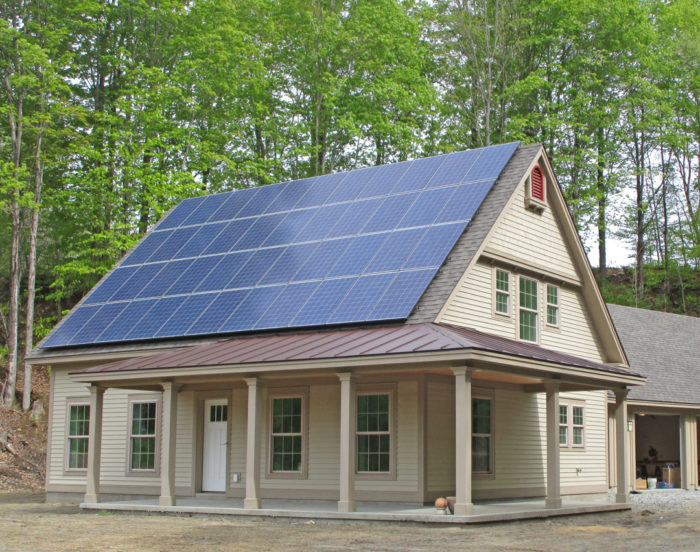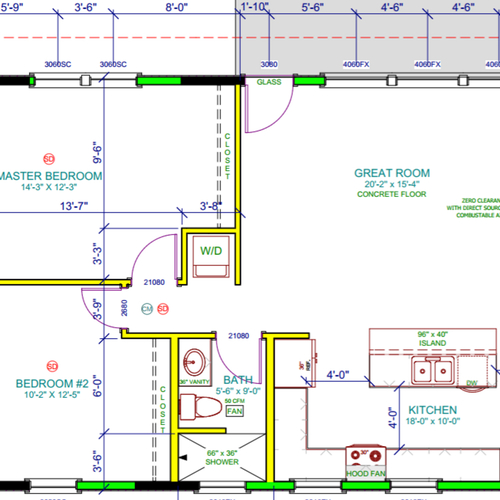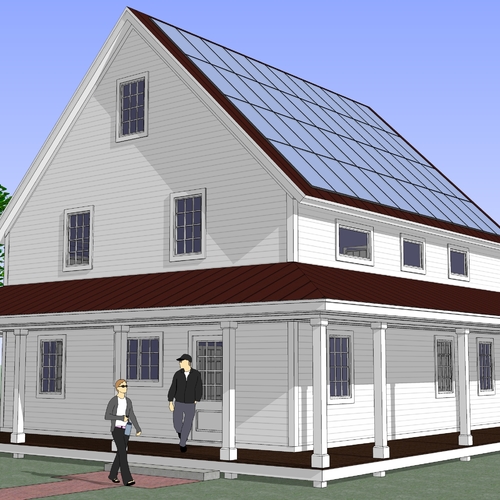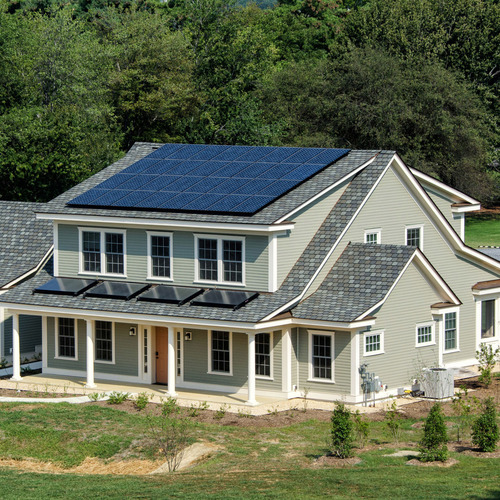
Image Credit: Martin Holladay
An 6-kW photovoltaic (PV) system can be installed for about $18,000 in many U.S. locations. With a 30% federal tax credit, the system costs the homeowner only $12,600 — or even less if utility or state rebates are available.
This 6-kW system will produce about 8,000 kWh per year in Boston (worth about $1,600) or 10,300 kWh per year in Phoenix (worth about $1,230). That’s a lot of electricity.
If you want to save between $1,200 and $1,600 per year on your heating or air conditioning bill, and you are willing to invest up to $12,600 to make it happen, you’ll probably find that adding insulation or new windows won’t get you to your goal. However, adding a PV system will.
Back in late 2006, when a Habitat for Humanity house in Wheat Ridge, Colorado, became the first house in the U.S. to achieve 12 months of net-zero-energy use, the net-zero goal was challenging. Eleven years later, the net-zero-energy goal is routinely achieved by builders all over North America. That’s because designing and building a net-zero energy house is becoming easier and easier.
Less expensive PV means a less expensive thermal envelope
The usual way to design a net-zero-energy house is to stop improving the thermal envelope of the house when the envelope improvements cost more per unit of energy saved than an investment in a bigger PV system.
In 2007, installing 1 kW of PV cost about $8,500. These days, the same PV system costs only $3,000 or $3,500. As the price of PV drops, investments in envelope improvements make less and less sense. Why upgrade to triple-glazed windows when the windows won’t save as much energy as an equivalent investment in PV?
With less expensive PV, today’s optimized net-zero-energy home will have a thermal envelope that performs worse and costs less to build than the optimized net-zero-energy homes of…
Weekly Newsletter
Get building science and energy efficiency advice, plus special offers, in your inbox.

This article is only available to GBA Prime Members
Sign up for a free trial and get instant access to this article as well as GBA’s complete library of premium articles and construction details.
Start Free TrialAlready a member? Log in















26 Comments
PV doesn't heat a building
Cost-justifying alternatives is certainly important. This article is a starting point. I hope people don't read this article, then just calculate the cost of PV vs. cost of insulation, its a lot more complicated than that.
PV doesn't heat or cool a home. The cost of a larger capacity or multiple mini-splits, resistance electric heating, or a cheap window AC unit have to be included in comparisons with higher insulation levels. Heating and cooling systems don't last as long as PV, require regular maintenance, occasional repairs, and some replacement after a decade. Those costs need to be included too. One nice feature of insulation and most air-sealing is that (properly installed) it lasts virtually forever, requires no maintenance, and needs no occupant attention. I'd add that into the bullet list provided in the article.
Another addition to the bullet list: Some would object that the source energy and sustainability of our choices need to be examined too, not just comparing costs. I'd guess that certain types of insulation would be superior to PV if we looked at more than just raw cost and payback comparisons (e.g., cellulose, mineral wool?), and other types would fare poorly (e.g., XPS?)
Getting a little off topic...What annoys me the most is that whenever the word "insulation" is mentioned, immediately people bring up cost justification. Fossil fuel heating systems are complex with many components, and I don't see quotes about their costs for the entire system with all components, including yearly maintenance, occasional repairs and replacements. Not to mention health and safety issues and global warming. Just cost-justifying insulation. Anybody care to provide a ballpark range of costs, or an article, on the total costs involved in fossil-fuel heating for an average US home in a northern US climate? Ten or 15 grand buys an inordinate amount of insulation and air-sealing.
Response to Robert Opaluch
Robert,
You're right, of course, that PV doesn't heat a building. For that matter, neither does insulation. Clearly, good air sealing measures, thick insulation, and low-U-factor windows reduce heating costs, which is why GBA has always advocated in favor of these features. But even Passivhaus buildings need to invest in a heating system.
In most cases, Passivhaus buildings in the U.S. are heated with ductless minisplits -- just like most "pretty good" houses. So I don't anticipate large capital savings in the HVAC department from adopting the Passivhaus approach. Every house in a cold climate needs some type of heating system.
Calculating the long-term cost of particular heating appliances is difficult, but it makes sense to attempt such calculations. (I've written several articles, for example, on the cost of maintaining solar thermal systems -- a line item that many people ignore.) Electric resistance heat is cheap to install, long lasting, and low maintenance. It's a "dumb as a rock" system, and it sometimes makes sense for a highly insulated building -- but it certainly raises energy bills compared to a ductless minisplit. Will the electric resistance heater save enough money in reduced maintenance costs over the next 25 years for this approach to beat out a ductless minisplit? I seriously doubt it, but it's worth doing the math.
Your tag line -- "PV doesn't heat a building" -- is accurate, but it may lead some readers to conclude that they need to install an oil-fired boiler. That's not your intent, I know -- but I think that most of us who care about global climate change can agree that we need to focus on all-electric solutions.
-- Martin Holladay
Second response to Robert Opaluch
Robert,
Thanks for your two bullet point suggestions. Your point about the expected service life of insulation being longer than the expected service life of a PV system is an important one -- I've discussed the issue in several previous articles, but I must have had a senior moment when writing this article. That point belongs on my bullet list, and I've added it. Thanks for pointing out the omission.
The second point you suggested -- "the source energy and sustainability of our choices need to be examined too, not just comparing costs" -- is certainly true, and GBA has been on that bandwagon for years, regularly reminding our readers to forego XPS and favor cellulose. But the subject opens up a whole arena of issues that, while important, are tangential to the topic under discussion. I don't want to limit discussion of the issue in our comments section, because it's a key point for green builders, but I have chosen not to add it to the bullet list.
-- Martin Holladay
Metrics matter
One kwh put into the grid during a period of grid excess and taken out during a peak usage time isn't "net zero" in terms of environmental impact. Ie, it's possible for a net positive use house to be greener than a net zero one.
There is a lot of sense in stepping back and thinking about what one is trying to achieve. Investing in utility scale solar or donating to some political cause might achieve more for less $.
Water, lifecycle costs and financial/technology learning curves.
In homes that can meet Net Zero Energy with an array that fits on the house the biggest slice of the home energy pie is domestic hot water. That isn't going to change with a higher performance building envelope. But self-consumption of rooftop PV output directed toward water heating as the power dump is a dirt-cheap cost adder. (~USD$100/water heater).
Maintenance costs of PV are near-zero, comparable in cost to maintaining window & door weatherstripping. At end of life after 20-40 years the replacement PV system is likely to be FAR cheaper (and more reliable) than the initial system, due to the dramatic double-digit percentage learning curve of PV technology, dropping ~20% in cost with every doubling of manufacturing / installations volumes. What costs $3/watt today is likely to cost under $0.50/watt by 2040. This is not pie-in-sky. Utility scale PV is currently costing less than $1/watt all-in, before subsidy, and small scale rooftop pricing has lagged utility scale pricing by only 3-5 years for the past couple of decades. Net metering isn't likely to be still in effect for new systems by then, but at the learning curve of battery technology self-consumption with PV + batteries on grid connected systems is likely to be cheaper than today's residential retail rate.
Even PassiveHouses need mechanical systems for heating & ventilation. The difference in installed cost of a 3/4 ton heat pump for a PassiveHouse vs. a 1.5 tonner capable of meeting the loads of a typical Net Zero house is less than $5K. Maintenance costs are nearly identical. Ventilation system costs and hot water heating equipment costs are identical. At end of life after 15-25 years the difference in cost between a replacement 3/4 ton and 1.5 ton minisplit should be under $2k, and the efficiency will be 10-25% higher, requiring even less power.
Freeze up durning extended power outages in a Net Zero house isn't likely except in the cold edge of US climate zone 7 or into zone 8.
Comfort measurements?
Martin, you mention in the article that all six points for argument #2 are debatable. I understand the benefits and/or importance of points 2-6 are debatable, but am hopeful that some type of objective measurements, maybe even converted to rules of thumb can help reduce the debate on comfort provided by R value. Seems like window U value and temp extremes per climate zone would be the most relevant factors to take into account in the comfort evaluation. Any hints on where one might find research along these lines?
Response to Mitchell Costa
Mitchell,
There has been a lot of research on comfort over the years, some of it dating back to the 1950s and 1960s, by ASHRAE and academic researchers. Much of the research involved college students sitting around in their underwear, as researchers adjusted the thermostat. (Literally.) Later research involved people of all ages.
For more information on this topic, see What is Comfort?
The short version: It's debatable.
If you collect 10 people, dressed similarly, and put them all in a room, it is highly unlikely that there will be a thermostat setting that will satisfy all 10 people.
In broad strokes, adjusting the thermostat is easy. Almost every house in America allows people to turn the thermostat up or down. Beyond choosing a thermostat setting, here are a few relevant issues:
1. Air leakage rates affect comfort. In a cold climate, a house with a high air leakage rate will have cold floors and hot ceilings. This leads to comfort complaints, so tight houses tend to be more comfortable than leaky houses. For more on this issue, see Cold Floors and Warm Ceilings.
2. Uneven temperatures from room to room. This problem is common, and is related to two issues: (a) Poorly designed HVAC systems (especially HVAC distribution systems), and (b) Rooms with oversized, unshaded east-facing or (especially) west-facing windows with high SHGC.
3. Radiative discomfort related to cold interior surfaces. In U.S. homes, this problem is limited to single-glazed or double-glazed windows, since drywall, flooring, and ceilings are generally in the right temperature range. (There are exceptions: uninsulated ceilings in hot climates can radiate heat, but uninsulated ceilings are illegal.) In my experience, ordinary double-glazed low-e windows with argon gas fill generally work fine for almost everybody until the temperature drops to 0 degrees F. Below zero, at least for some people, triple glazed windows start to matter.
There is more to say on this matter. But suffice it to say that a properly designed, properly built code-minimum house is rarely uncomfortable, as long as the builder pays attention to airtightness. Passive House claims on the comfort issue -- that you have to adhere to the Passive House standard to achieve comfort -- are overstated.
Window comfort
There is a nice window comfort calculator here:
http://www.payette.com/building-science/glazing-and-winter-comfort-tool
Sitting idle close to tall windows can be a draft comfort issue, especially with room-side low-E coatings and light clothing. But apparently this is easily fixed with a small bump in room temperature.
This is why we're friends
Question authority! Examine Assumptions! Damn the Torpedoes! To the Barricades!
Response to Dan Kolbert
Dan,
I'm just guessing here -- [scratches head] -- but are you perhaps expressing a hearty endorsement of the "pretty good house" approach?
hearty-burny
but yes
Will electric vehicles change this...
As big auto invests huge in electric cars how will this effect the net zero argument? How much power would be needed to charge 2 electric vehicles? Given this new demand, the argument could be made that adding more insulation, hopefully reducing heating demand, if you are going electric or electric heat pump, could free up more power for recharging a vehicle.
Response to Kye Ford
Kye,
Q. "How much power would be needed to charge 2 electric vehicles?"
A. Here are links to two web sites that answer the question:
http://www.afdc.energy.gov/fuels/electricity_charging_home.html
https://pluginamerica.org/how-much-does-it-cost-charge-electric-car/
One site estimates 34 kWh per 100 miles, and the other site estimates 30 kWh. Let's call it 32 kWh.
The average American car is driven about 13,500 miles per year. Two cars would be 27,000 miles. That would require 32 x 270 = 8,640 kWh of electricity. So, if you have a 6-kW PV system for your house, you would need to install another 6-kW PV system (perhaps on a ground-mounted array, or on your garage roof) to take care of your vehicles.
Martin, I think those EV fuel efficiency estimates are too high. I own a LEAF and get, consistently, 13 kWh per 100 km. Those readings are taken from the dash display. That's 21 kWh per 100 miles. I have seen figures of 20 kWh/100 km for Tesla Model S's, which is in your range for sure.
Ben,
Thanks for the data. So anyone interested in this calculation should add a few more PV modules to be safe.
Second response to Kye Ford
Kye,
Q. "As big auto invests huge in electric cars, how will this effect the net zero argument?"
A. The net-zero argument rests on cost-effectiveness. If we use the same yardstick to answer the question, "Should I invest in a PV array to charge my car?" the relevant factors are fewer than they are for a net-zero house. If we leave environmental concerns out of the equation, all the owner really cares about is whether PV-generated electricity is cheaper or more expensive than grid-supplied electricity.
As long as the local utility offers a net-metering contract, the answer in much of the U.S. is that the PV-generated electricity is cheaper. That may not be true, however, if you live somewhere where grid-powered electricity is cheap, and it certainly isn't true if your local utility doesn't offer a net-metering contract.
When net metering is not available...
Martin,
Alas, some of us live in areas where net metering is not available or discouraged by our local utilities. In my state of Indiana, the legislature just took a large step in precisely the wrong direction when it passed a bill which will compensate small-scale power generators at the wholesale rate +25% (about $0.04/kWh) rather than the retail rate (about $0.09/kWh).
Even before that, some utilities (including my local cooperative) skirted their obligation to net meter by requiring a "premium" connection fee of about $40/month over the regular fee. The price of the premium fee is subject to change at the whim of the utility, and goes only one direction (up each year).
For those of us stuck in such unhappy political climates, all is not lost. For perhaps $2,000-$3,000, a homeowner can install a small battery backup system and an upgraded inverter which operates as a load-shifter. Excess power generated during the day is stored in the batteries, and drawn at night when it is (typically) needed. Once the batteries are sufficiently discharged to leave capacity for the next day's expected power generation, the inverter switches back to grid power.
The size of the battery bank can be optimized to provide enough capacity to "spend" a sunny summer day's collected energy at an appropriate depth of discharge (DoD). On shorter or less sunny days, the DoD will be low (say, 25% or less), ensuring a long service life and low annualized cost of the battery bank. This type of system has the side benefit of providing viable backup power from the solar panels in the event of a power outage, a feature which may alone justify the additional cost of the batteries in the minds of some owners.
Brian, how far from "off grid" will you then be?
I'm looking at a new build on raw land in New York State and seeking information on what a new ~300ft connection to the grid will cost and whether - despite the assertions on other threads that this is antisocial behavior - creating an off-grid pv/battery system or two-unit district might make sense.
Response to Brian Bailey
Brian,
In states like yours, where the local utility doesn't offer a net metering contract, the economics of PV shift significantly. The payback period for a PV investment becomes much longer.
In addition to your suggested approach -- adding a battery bank with the appropriate inverter and controls -- you might consider installing a second electric water heater, hard-wired to a PV array. The size of the PV array has to be matched to the size of the tank to avoid overheating, and the system would probably have to be disconnected when you go on vacation. This water heater can be piped in series with your existing water heater (functioning as a pre-heater).
Response to Ethan T
Ethan,
In my scenario, the battery bank is pretty small - just enough to capture and discharge the energy gathered on a hypothetically sunny June 21, minus "baseload" power consumption, which is mostly a refrigerator/freezer and some constant loads like the a radon mitigation fan, internet router, etc. For my 4.3kW system, this adds up to less than 10kWh total useable battery capacity.
For an off-grid system, a much larger battery system is needed to get through a stretch of cloudy days in winter without excessive generator use. I would guess that a reasonably miserly off-grid energy consumer could get by with a battery bank costing $10,000. But overall winter energy sources in New York are a whole other can or worms, as Martin is well aware from his own off-grid living arrangement. Solar alone is not enough to power more than lights and a few appliances through a dark, cloudy winter, even with substantial battery capacity.
Response to Ethan T (Comment #16)
Ethan,
Q. "I'm looking at ... whether ... creating an off-grid PV/battery system or two-unit district might make sense."
A. Don't do it. Off-grid electricity costs between 50 cents and $1 per kWh. It's expensive. The big expense isn't the PV modules -- PV modules are cheap. The big expense is the battery, the backup generator, and the fuel to operate the generator.
More information here: Batteries for Off-Grid Homes.
One semi-standard solution for self consumption...
A method of ensuring self consumption in non net-metering situations has been small controllers that dump the excess power that would otherwise be exported to the grid at a pittance into an electric water heater. Whether this is viable/legal varies by utility & regulator. In some places 100% export to the grid and 100% import from the grid is required, with no legal means of self-consumption behind the meter if it's grid-attached. (In those abusive situations, when the PV is active and power is being used, the customer is being charged for use of the "grid" that comprises the piece of bus-bar between the import & export meters- power that never even left the property!)
But assuming it can be applied, a self consumption controller for a water heater is a heluva lot cheaper than batteries! This approach presumes that water is already being heated with electricity.
At current battery & PV pricing, even with federal tax subsidies you're looking at self-consumption power with a levelized lifecycle cost well in excess of $0.09/kWh, but it might be as low as $0.35/kWh by now. But with tax and other incentives the levelized cost of PV can be under $0.09/kWh. At an 18% capacity factor (typical for Indiana) and a 4% discount rate you'd need to get the all-in installed cost (after incentives) down to the $2/watt range to beat 9 cents.
But even if the levelized cost of self generated power isn't the issue, self consumption with water heater storage is a small fraction of the cost of self consumption with battery storage.
Solar water heating
Martin, Dana,
Thanks for your comments - I'm convinced to take another look at heating water with excess power generation.
Are you aware of any off-the-shelf, cost effective solutions for a hard-wired system, or are these solutions still exclusively DIY (e.g., a standard electric hot water heater with retrofitted DC resistive heating elements)?
Response to Brian Bailey
Brian,
A company called Next Generation Energy in Lafayette, Colorado, makes a PV-powered electric water heater system called the Sun Bandit.
The company has a terrible web site that avoids providing a clear description of the technology or control system, so I've always abandoned the web site in frustration at each visit. I'm not sure how the controls work.
Here is some info from the company's FAQ page:
"Q. Do I need a net meter to install Sun Bandit?
"A. No, Sun Bandit Micro-Grid technology works regardless of the grid and has no interface to the grid on the Sun Bandit side."
Second response to Brian Bailey
Brian,
Here is a link to an article explaining how they're doing it in Australia:
How To Divert Your Excess Solar PV to a Hot Water Cylinder.
More on these "guerilla" solutions in Australia: Solar Installers Are Getting Around Utilities’ Restrictions.
Third response to Brian Bailey
Brian,
Here is a packaged solution sold in the U.K.: SunAmp PV.
Log in or become a member to post a comment.
Sign up Log in